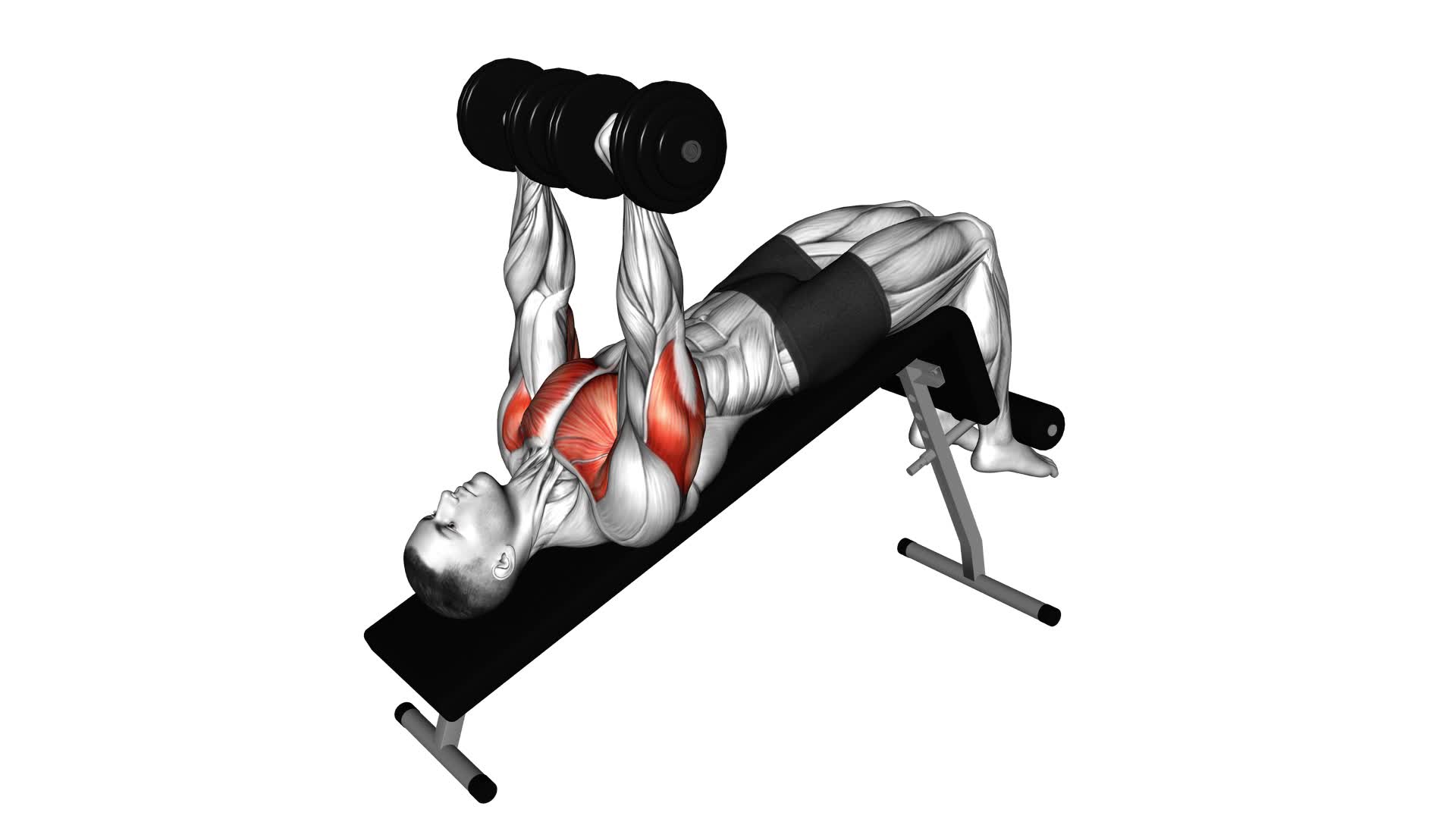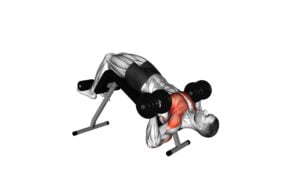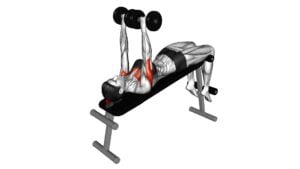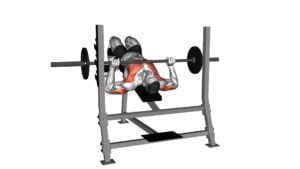Dumbbell Decline Bench Press – Video Exercise Guide & Tips

Are you looking to tone your chest and build strength?
Watch This Exercise Video
The dumbbell decline bench press is a great exercise for targeting your lower chest muscles.
In this video exercise guide, we'll show you the proper set-up, correct form, and variations to keep your workouts challenging.
Avoid common mistakes and maximize your results with these helpful tips.
Get ready to level up your chest workout with the dumbbell decline bench press!
Key Takeaways
- The dumbbell decline bench press targets and strengthens the lower chest muscles, pectoralis major, and pectoralis minor.
- Proper bench height and dumbbell selection are important for maintaining stability and form during the exercise.
- Safety equipment such as a spotter or weightlifting belt should be used, and proper form and technique should be followed to prevent injuries.
- Varying the rep range, gradually increasing weight, and incorporating variations and progressions can help maximize results and challenge the muscles.
Benefits of the Dumbbell Decline Bench Press
One major benefit of the dumbbell decline bench press is that it targets and strengthens your lower chest muscles. This exercise is specifically designed to activate the muscles in your lower chest, including the pectoralis major and the pectoralis minor. By performing the dumbbell decline bench press, you can effectively isolate and engage these muscles, leading to increased muscle activation and growth.
Unlike the traditional bench press, which primarily targets the middle and upper chest, the decline bench press shifts the emphasis to the lower chest region. This allows you to develop a well-rounded and balanced chest, with equal focus on both the upper and lower portions. By incorporating the dumbbell decline bench press into your workout routine, you can sculpt and define your lower chest area, creating a more aesthetic and proportional physique.
In addition to targeting the lower chest muscles, the dumbbell decline bench press also engages other muscle groups such as the triceps, shoulders, and core. This compound movement not only helps to strengthen and build muscle in these areas but also improves overall upper body strength and stability.
To maximize the benefits of the dumbbell decline bench press, it's important to maintain proper form and technique. Keep your feet securely anchored on the decline bench, maintain a stable and controlled motion throughout the exercise, and use a weight that challenges you without compromising form. With consistent practice and proper execution, the dumbbell decline bench press can be a valuable addition to your chest workout routine.
Proper Set-Up and Equipment
To ensure proper set-up and equipment for the dumbbell decline bench press, there are a few key points to consider.
First, make sure the bench is at the correct height to allow for a full range of motion without straining your shoulders or back.
Next, choose the appropriate dumbbell weight that challenges you but still allows for proper form.
Lastly, don't forget to have any necessary safety equipment, such as a spotter or weightlifting belt, to ensure a safe and effective workout.
Correct Bench Height
Adjusting the bench height is crucial for an effective dumbbell decline bench press. When the bench is too low, it can strain your shoulders and limit your range of motion. On the other hand, if the bench is too high, it can cause instability and compromise your form.
To adjust the bench height, consider your fitness level. Beginners may need a lower bench height to maintain stability and prevent injury. More advanced individuals may prefer a higher bench height to challenge their muscles and increase their range of motion.
Experiment with different heights to find the one that allows you to perform the exercise with proper form and maximum effectiveness.
Proper Dumbbell Selection
To ensure proper set-up and equipment for the dumbbell decline bench press, you should carefully select the appropriate dumbbells. Choosing the right dumbbell weight is crucial to ensure an effective and safe workout. Here are three key factors to consider when choosing dumbbells:
- Fitness level: Select a weight that challenges your muscles but still allows you to maintain proper form throughout the exercise. Beginners may start with lighter weights and gradually increase as they build strength and confidence.
- Exercise goals: Determine whether you want to focus on building muscle size and strength or improving muscular endurance. Lower weights with higher repetitions are ideal for endurance, while heavier weights with fewer repetitions are better for strength gains.
- Proper form: It's essential to maintain proper form during the exercise. If you find yourself struggling to lift the dumbbells with proper technique, consider choosing a lighter weight to prevent injuries and maximize results.
Safety Equipment Requirements
Ensure your safety by using proper equipment and set-up for the dumbbell decline bench press. Safety precautions and essential gear are vital to prevent injuries during this exercise.
First, make sure you have a sturdy decline bench with a secure footrest. Adjust the bench to a decline angle that suits your comfort level and fitness goals.
Additionally, use a spotter or safety bars to catch the weights if you can't complete a rep. It's crucial to wear appropriate workout attire, including athletic shoes with good traction to prevent slips. Don't forget to use weightlifting gloves for a better grip and to protect your hands from calluses.
Lastly, always warm up before starting the exercise to prepare your muscles and joints for the workout.
Correct Form and Technique
To ensure proper alignment during the dumbbell decline bench press, keep your feet firmly planted on the ground, your back flat against the bench, and your shoulder blades pulled back and down.
Avoid common mistakes such as arching your back, flaring your elbows, or allowing your wrists to collapse.
Proper Alignment During
Maintain proper alignment by positioning your body correctly during the dumbbell decline bench press exercise. Here are three key points to help you achieve proper alignment and technique:
- Importance of core engagement: Engaging your core muscles, specifically your abdominal muscles, is crucial in maintaining stability and proper form during the exercise. This will help protect your lower back and prevent any unnecessary strain or injury.
- Breathing techniques during the exercise: Focus on exhaling as you push the dumbbells up and inhaling as you lower them down. This rhythmic breathing pattern helps stabilize your core and promotes better control and efficiency in your movements.
- Shoulder and hip alignment: Ensure that your shoulders are pulled back and down, away from your ears, throughout the exercise. Your hips should be positioned firmly on the bench and in line with your shoulders, providing a stable foundation for the exercise.
Common Mistakes to Avoid
To avoid common mistakes in form and technique, consistently focus on maintaining proper alignment during the dumbbell decline bench press exercise. One common mistake to avoid is arching your back excessively, as this can lead to lower back strain and potential injury. Keep your back flat against the bench throughout the movement to ensure proper spinal alignment.
Another mistake is using too much weight, which can compromise your form and increase the risk of injury. Start with lighter weights and gradually increase as you become more comfortable and confident.
Additionally, be mindful of your shoulder position. Avoid shrugging your shoulders or allowing them to roll forward, as this can limit muscle activation and lead to imbalances.
By avoiding these common mistakes, you can improve muscle activation and reduce the risk of injury.
Now, let's move on to the next section about variations and progressions.
Variations and Progressions
To progress and vary your dumbbell decline bench press, you can incorporate different grip positions and adjust the angle of the bench. This will challenge your muscles in new ways and prevent plateauing. Here are three variations and progressions you can try:
- Wide Grip: Instead of using a standard grip, place your hands wider apart on the dumbbells. This targets your chest muscles more intensely and increases the range of motion.
- Neutral Grip: Hold the dumbbells with your palms facing each other. This grip reduces stress on your wrists and activates your triceps and shoulders to a greater extent.
- Incline Decline Bench: Adjust the bench to a decline or incline position. Decline bench press targets your lower chest, while incline bench press focuses on your upper chest. You can alternate between these positions to work your chest muscles from different angles.
These variations and progressions can be used as advanced techniques to continue challenging your muscles and promoting growth. Remember to start with lighter weights and gradually increase the intensity as you become comfortable with each variation. Keep proper form and listen to your body to avoid injuries.
Common Mistakes to Avoid
Avoiding common mistakes is crucial when performing the dumbbell decline bench press exercise. To ensure proper alignment and maximize your results, it's important to be aware of these mistakes and avoid them.
One common mistake is using too much weight. It's essential to start with a weight that you can comfortably handle and gradually increase it as you progress. Using too much weight can compromise your form and increase the risk of injury.
Another mistake is arching your back excessively. While a slight arch is natural, excessive arching can strain your lower back and shift the focus away from your chest muscles. Maintain a neutral spine throughout the exercise.
Additionally, avoid flaring your elbows out to the sides. This puts unnecessary stress on your shoulder joints and limits the effectiveness of the exercise. Instead, tuck your elbows in at a 45-degree angle to engage your chest muscles more effectively.
By avoiding these mistakes and maintaining proper alignment, you can perform the dumbbell decline bench press exercise safely and effectively.
Now, let's move on to the next section to learn some tips for maximizing your results.
Tips for Maximizing Results
To maximize your results, incorporate these tips into your dumbbell decline bench press routine:
- Vary your rep range: To maximize gains and avoid plateaus, it's important to vary your rep range. While lower reps (4-6) focus on building strength, higher reps (12-15) target muscle endurance. Incorporating both into your routine will help you build muscle mass and avoid hitting a plateau.
- Increase weight gradually: Continuously challenging your muscles is key to maximizing gains. Gradually increase the weight you lift over time to ensure progressive overload. This will stimulate muscle growth and prevent your body from adapting to the same routine.
- Focus on form and control: Proper form is crucial for maximizing results and avoiding injuries. Maintain control throughout the exercise, ensuring a slow and controlled descent of the dumbbells. Keep your core engaged and your back flat on the bench to target your chest muscles effectively.
By following these tips, you can maximize your gains and avoid plateaus in your dumbbell decline bench press routine.
Remember to listen to your body, rest when needed, and consult with a fitness professional if you have any concerns or questions.
Frequently Asked Questions
How Much Weight Should I Start With When Performing the Dumbbell Decline Bench Press?
When starting the dumbbell decline bench press, it's important to choose a weight that challenges you but allows you to maintain proper form. Start with a weight that you can comfortably handle for 8-12 reps.
As you progress, gradually increase the weight and aim for 6-8 reps. Utilize progression techniques like adding weight or adding an extra set to continue challenging your muscles and promoting growth.
Remember to listen to your body and adjust accordingly.
Can I Substitute the Dumbbell Decline Bench Press With a Barbell Decline Bench Press?
Yes, you can substitute the dumbbell decline bench press with a barbell decline bench press.
The main difference between the two is the equipment used.
The dumbbell decline bench press allows for more independent movement of each arm, providing a greater range of motion and targeting the chest muscles more effectively.
However, the barbell decline bench press allows for heavier weights to be lifted, which can help increase overall strength.
Both exercises have their own benefits, so it's up to personal preference and fitness goals.
Are There Any Specific Breathing Techniques to Follow During the Exercise?
During the dumbbell decline bench press, it's important to follow specific breathing techniques. As you lower the dumbbells, exhale and brace your core. Inhale as you push the dumbbells back up. This helps stabilize your body and maintain proper form.
Incorporating the dumbbell decline bench press into your chest workout offers numerous benefits. It targets the lower chest muscles, increases strength and muscle mass, and improves overall chest development.
Can the Dumbbell Decline Bench Press Help in Building Overall Chest Strength?
The dumbbell decline bench press can definitely help you build overall chest strength. By incorporating this exercise into your chest workout routine, you can target the lower part of your chest, which is often harder to develop.
To perform it properly, lie on a decline bench with dumbbells in hand, lower them slowly towards your chest, and then push them back up explosively. This exercise engages your chest muscles and promotes muscle growth for a stronger chest.
Is It Necessary to Have a Spotter While Performing the Dumbbell Decline Bench Press?
Having a spotter while performing the dumbbell decline bench press is highly recommended. It ensures your safety and helps you push your limits.
A spotter can assist you in lifting heavier weights and prevent injury by guiding the dumbbells back to the rack if you fatigue. They can also provide feedback on your form and technique, helping you maintain proper alignment and maximize the effectiveness of the exercise.
Conclusion
In conclusion, the dumbbell decline bench press is a highly effective exercise for building chest and tricep strength. By following proper set-up and equipment guidelines, maintaining correct form and technique, and incorporating variations and progressions, you can maximize your results.
Avoiding common mistakes and implementing tips for success will help you achieve your fitness goals. Incorporate this exercise into your routine for a challenging and rewarding upper body workout.

Author
Years ago, the spark of my life’s passion ignited in my mind the moment I stepped into the local gym for the first time. The inaugural bead of perspiration, the initial endeavor, the very first surge of endorphins, and a sense of pride that washed over me post-workout marked the beginning of my deep-seated interest in strength sports, fitness, and sports nutrition. This very curiosity blossomed rapidly into a profound fascination, propelling me to earn a Master’s degree in Physical Education from the Academy of Physical Education in Krakow, followed by a Sports Manager diploma from the Jagiellonian University. My journey of growth led me to gain more specialized qualifications, such as being a certified personal trainer with a focus on sports dietetics, a lifeguard, and an instructor for wellness and corrective gymnastics. Theoretical knowledge paired seamlessly with practical experience, reinforcing my belief that the transformation of individuals under my guidance was also a reflection of my personal growth. This belief holds true even today. Each day, I strive to push the boundaries and explore new realms. These realms gently elevate me to greater heights. The unique combination of passion for my field and the continuous quest for growth fuels my drive to break new ground.







